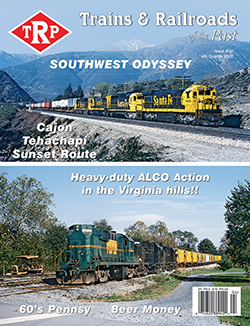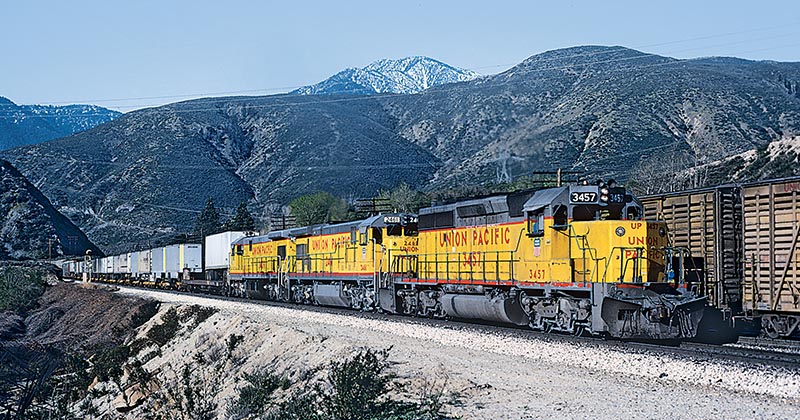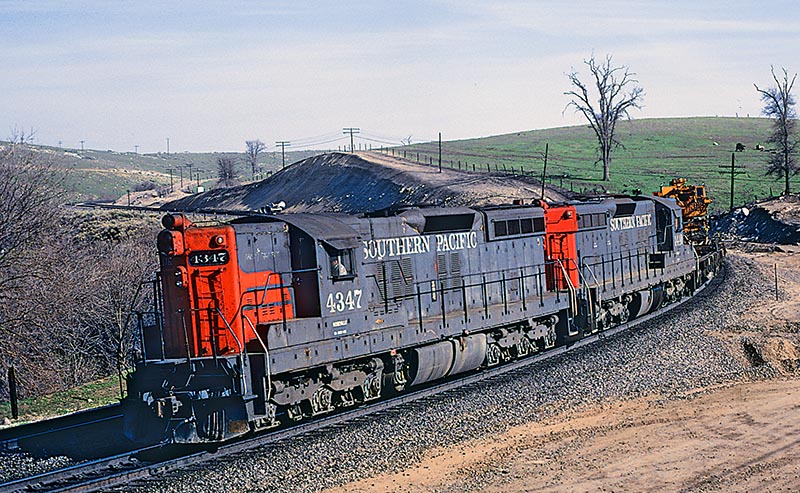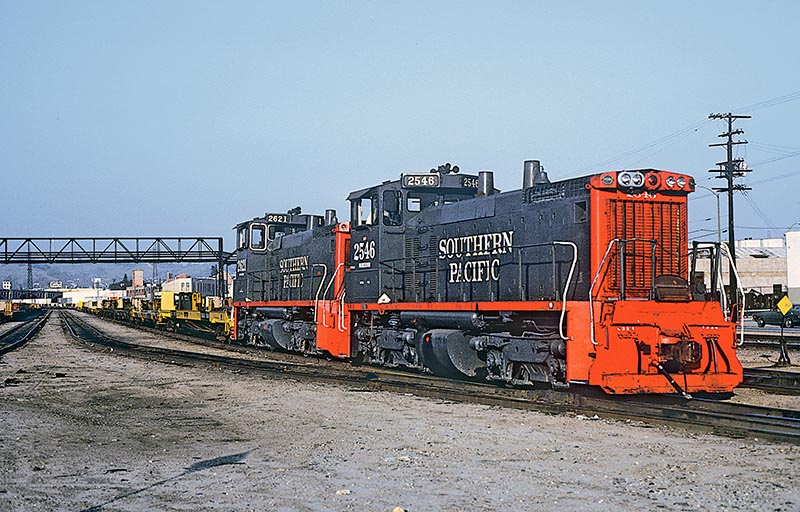 by Dave Ori/photos by the author
by Dave Ori/photos by the author
New Mexico, The Land of Enchantment, with its azure blue skies and rugged and barren terrain. Arizona, with its breathtaking scenery – towering mountaintops that nearly reach the heavens, the Petrified Forest near Holbrook and the smell of ponderosa pines throughout the Kaibab National Forest between Flagstaff and Williams. California, The Golden State, with the sun setting across the scorching sands of the Mojave Desert and its thundering mountain railroads crossing Cajon Pass and the famed Tehachapi Loop south of Bakersfield. Welcome to A Southwest Odyssey.
I became intrigued with southwestern railroading in the summer of 1971 when my brother and I accompanied my aunt and uncle on a trip from Cleveland, Ohio, to southern California. Between Gallup, N.M., and San Bernardino, Calif., Santa Fe’s Chicago-Los Angeles main line roughly parallels Route 66, the Mother Road. I witnessed the passage of numerous Santa Fe trains hustling freight between the Midwest and West Coast. Another trip back to the Los Angeles region (otherwise called The Southland), back in 1975 solidified my interest in railroads operating in the Golden Empire.

ABOVE: Snow-capped Mt. Baldy towers high in the background as symbol train LACST (Los Angeles-Canal Street Trailers) begins its tortuous climb up the west slope toward Cajon Summit, threading its way eastward on March 22, 1985. Limited to 55 cars with a max speed of 70 m.p.h. where applicable, the LACST often ran in two sections from Los Angeles, carrying UPS traffic for Las Vegas, Salt Lake City and Chicago. Its counterpart, the CSLAT (Canal Street-Los Angeles Trailers), can be seen heading west on the North Track with a block of livestock cars on the head end. Up until early 1985, the Union Pacific carded a train known as the CLS (California Livestock Special). The CLS carried hogs between UP’s major classification yard at North Platte, Nebraska, and Farmer John’s Los Angeles meat packing facility. The history of symbol CLS can be traced back to 1964 when UP trains DLS (Daylight Livestock Special), which operated between Salt Lake City and Los Angeles, and the Council Bluffs-Salt Lake City Coast Livestock were consolidated to form the California Livestock Special. In 1971, Swift, a major meat producer, closed its Los Angeles operation, leaving only one customer, Clougherty’s Packing Co. (Farmer John), who received hogs from midwestern points. In order to retain this business, UP spent $1.2 million to renovate 270 triple-deck hog cars that eliminated the need for a rest stop at Salt Lake City and installed watering troughs inside the cars to allow in-car feeding and watering. In order to keep the hogs cool during the summer months, the UP built a hog drenching and watering facility at Dry Lake, Nevada. To keep the hogs warm during the winter months, UP installed operable steel shutters on the cars’ sides. In July 2022, Smithfield Foods (who owns Farmer John) announced it was closing it Vernon (Los Angeles) facility.
Flash forward to early 1985. Several members of our railroad club in Cleveland (Forest City Division-Railroad Enthusiasts) discussed making a trip out west to photograph railroad action on the Rio Grande, Santa Fe, Union Pacific, and Southern Pacific. We departed in mid-March to take advantage of the lower sun angle and the longer days of late winter and arrived in Denver for the first leg of our trip to shoot Rio Grande passenger and freight action in the Rocky Mountain range. We also spent a day on the Santa Fe-Burlington Northern joint line between Denver and Palmer Lake and a two-day stint on the UP between Cheyenne and Laramie, Wyoming.
After wrapping up in Colorado, we boarded a flight from Denver to Ontario, Calif., (east of L.A.), and continued our southwestern adventure. After landing, we picked up our luggage and rental vehi-cles and made a bee line to San Bernardino for some much-needed rest. The next day, March 20, we followed the Palmdale Cut-off over Cajon Pass and took California State Highway 138 west as we headed toward Mojave. The plan was to spend two days at Tehachapi Loop, covering the joint SP/Santa Fe operation between Mojave and Bakersfield. At Mojave, we encountered an SP eastbound, the RVWCY (Roseville-West Colton Yard).
We chased him east for a short distance before returning to Mojave, where we noticed a head-light fast approaching us. It was Santa Fe Train 975 descending the Tehachapi Mountains that were shrouded in fog. Luckily, we had some good early morning light to work with. Train 975 pulled down to the east end of town and creaked to a stop. Just coming off the Mojave Sub from Barstow was Train 199, the Chicago, Ill., to Richmond, Calif., speedster. We decided to follow Train 199 as it began his climb. We shot him a few times before setting up for the classic shot at Tunnel 9. It was a real treat to see the train wind around The Loop as it made its way westward through Bealville and Caliente before taking the high road to Bakersfield.

ABOVE: In September 1984, Santa Fe received 18 SDP40F’s from Amtrak in exchange for 25 CF7s and 18 SSB1200 switchers. The Amtrak units operated across the breadth of the Santa Fe system before being sent to the San Bernardino Shops for remanufacturing in early 1985. Under a pristine blue sky, 5259 leads Train 858 eastbound through Victorville on Friday, March 22, 1985. Operating as-needed between Los Angeles and Barstow, it handled traffic for Barstow and beyond.
After Train 199 departed the Tehachapi Mountain Range, a Southern Pacific train with symbol EUWCY (Eugene, Ore.-West Colton Yard) began slithering its way across the mountain pass. We set up for a shot at Woodford, taking in the sights and sounds of mountain railroading at its best. We then returned to Tunnel 9 and upon arrival, we found an extra work train from Mojave doing some light maintenance. Once he completed his work, he scooted east back to Mojave, following the EUWCY. In all, we shot several trains crossing the Tehachapis that day.
Following that two-day stint in the Tehachapis, we drifted south towards Cajon Pass. We awakened the next day, March 22, as the sun rose above the San Bernardino Mountains. After a quick fast-food drive-thru breakfast, we darted up to Cajon Pass to begin a full day of photography. This has been a mecca for railfans since the mid-1900’s. The history of this region can be traced back to 1885 when the California Southern built the original line over the pass to connect its route from San Diego to the Santa Fe at Barstow.

ABOVE: ABOVE: In order to keep up with maintenance over this segment of Tehachapi Loop, it was necessary to call work trains as needed to repair rough rail conditions, replace ties and to remove any impediments, such as rocks and dirt from the right-of-way. On Wednesday, March 20, 1985, an extra work train from Mojave powered with a pair of legendary SP SD9E’s will make a quick repair at Walong. After waiting for a few trains to pass, they will perform the light maintenance assignment on this late winter day before returning east to Mojave. This is nothing compared to what the SP dealt with in 1952. A major earthquake rattled the Tehachapi Mountains on July 21 of that year, measuring a devastating 7.5 on the Richter scale. The quake killed 14 people and left a swath of destruction throughout Kern County. Southern Pacific suffered catastrophic damage to its rail net-work across the Tehachapi Mountains, especially between Caliente and Rowen, with numerous tunnels collapsing and rail being twisted and out of alignment. During the rebuilding process, all SP and Santa Fe trains were diverted to SP’s Coast Line route between Los Angeles and San Francisco, with westbound trains utilizing SP’s Santa Paula Branch between Montalvo and Burbank Junction via Saugus and eastbound and all passenger trains operating over the Coast Line via Santa Susana pass. Operations across Tehachapi Loop were restored in 25 days and on August 15, a SP westbound consisting of 100 Oregon empties would be the first train to operate over The Loop after the quake.
Due to an increase in traffic to southern California, a second main was constructed between San Bernardino and Barstow between 1912 and 1924. Another railroad, the San Pedro, Los Angeles and Salt Lake City Railroad (an early Union Pacific affiliate) acquired the Los Angeles Terminal and was completing its route between Salt Lake City and L.A. In order to reach the Los Angeles Basin, Santa Fe granted the SPLA&SLC trackage rights from Daggett to San Bernardino and Colton over Cajon. After an ICC order ruling in favor of the “Pedro,” a new agreement was established in February 1916, extending operating rights over the Santa Fe from Colton to just south of Riverside Jct. The SPLA&SLC became part of the UP in 1921…


